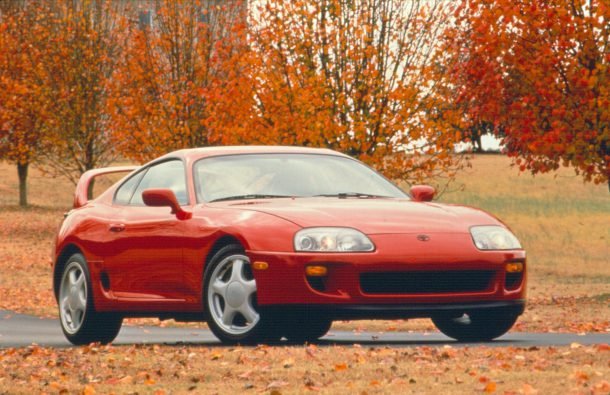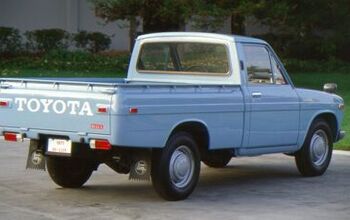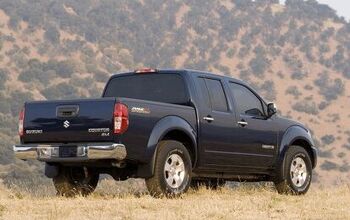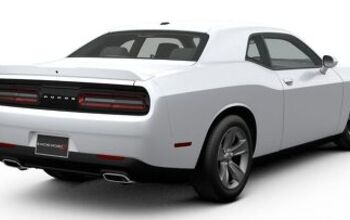Buy/Drive/Burn: Japanese Sports Cars From 1995

Today we decide which of three legendary and sporty Japanese coupe gets the flamethrower. Will it be the Toyota, the Mazda, or the Nissan? All of these vehicles are the last in their line, so this one might be a bit difficult.
Rear-drive, serious performance, twin-turbo motors, and sweet styling are the hallmarks of today’s trio — the short-lived pinnacle of the ’90s Japanese sports car.
Toyota Supra
The fourth generation Supra model began production in early 1993, as Toyota aimed to take its sports car in a more serious direction. Performance and handling were at the forefront of this new A80; previously those two had taken a back seat to luxury appointments and more brougham styling.
All Supras had the same 2ZJ inline-six engine, either with or without a turbocharger. Naturally aspirated versions had 220 horsepower, while turbo versions upped that figure to an impressive 320. Today’s selection is a turbo with six-speed manual — the best one. A four-speed automatic was also available, and was forced upon consumers starting with the ’96 model because of OBD-II requirements. 0-60 mph is yours in 4.6 seconds. Declining sports coupe sales would see Supra exit Canada after 1996, and the U.S. after 1998, with all ’98 models being of the naturally aspirated persuasion.
Mazda RX-7
Mazda’s RX-7 is the only rotary on offer today, not that it’s any surprise. In its third generation for the 1993 model year in the United States, Mazda nerds call it the FD. Like the Toyota, Mazda intended to tighten up the RX-7 and give it more serious credentials. While the 1.3-liter rotary engine carried over from the prior (FC) generation, the power figures did not. The previous model in turbo variation made between 202 and 215 horsepower; this time the figure was 276. A four-speed automatic or five-speed manual greeted customers, and obviously we’ve chosen the manual for today’s purposes. Though down on power over the Supra, it’s also between 600 and 800 pounds lighter, and that makes a difference. Short-lived, 1995 was the last year of the FC in North America, and RX-7 availability in other places ended after 2002.
Nissan 300ZX
Though the 300ZX was only the second version of its particular model name, the Z-car family stretches back to 1969, three generations prior to this Z32. For 1990, the Z32 300ZX replaced the predecessor Z31’s boxy shape and upright lines with smooth curves and a wide profile. The same VG30 3.0-liter V6 engine carried over from the prior model, but power increased like the others in our trio. A Z31 turbo managed 205 horsepower; the Z32 twin-turbo upped this figure to an even 300. Available in short (2-seat) and long wheelbase formats (2+2), today’s selection is a 2-seat hardtop version (no t-top) and punches in about the same weight as the Supra. Though the 300ZX would continue on in other markets through 2000, Nissan pulled it from the North American lineup after the ’96 model year.
Three great cars, six combined turbos. Will burning one Make You Cry?
[Images: Toyota, Wikipedia, Nissan]

Interested in lots of cars and their various historical contexts. Started writing articles for TTAC in late 2016, when my first posts were QOTDs. From there I started a few new series like Rare Rides, Buy/Drive/Burn, Abandoned History, and most recently Rare Rides Icons. Operating from a home base in Cincinnati, Ohio, a relative auto journalist dead zone. Many of my articles are prompted by something I'll see on social media that sparks my interest and causes me to research. Finding articles and information from the early days of the internet and beyond that covers the little details lost to time: trim packages, color and wheel choices, interior fabrics. Beyond those, I'm fascinated by automotive industry experiments, both failures and successes. Lately I've taken an interest in AI, and generating "what if" type images for car models long dead. Reincarnating a modern Toyota Paseo, Lincoln Mark IX, or Isuzu Trooper through a text prompt is fun. Fun to post them on Twitter too, and watch people overreact. To that end, the social media I use most is Twitter, @CoreyLewis86. I also contribute pieces for Forbes Wheels and Forbes Home.
More by Corey Lewis
Latest Car Reviews
Read moreLatest Product Reviews
Read moreRecent Comments
- Redapple2 jeffbut they dont want to ... their pick up is 4th behind ford/ram, Toyota. GM has the Best engineers in the world. More truck profit than the other 3. Silverado + Sierra+ Tahoe + Yukon sales = 2x ford total @ $15,000 profit per. Tons o $ to invest in the BEST truck. No. They make crap. Garbage. Evil gm Vampire
- Rishabh Ive actually seen the one unit you mentioned, driving around in gurugram once. And thats why i got curious to know more about how many they sold. Seems like i saw the only one!
- Amy I owned this exact car from 16 until 19 (1990 to 1993) I miss this car immensely and am on the search to own it again, although it looks like my search may be in vane. It was affectionatly dubbed, " The Dragon Wagon," and hauled many a teenager around the city of Charlotte, NC. For me, it was dependable and trustworthy. I was able to do much of the maintenance myself until I was struck by lightning and a month later the battery exploded. My parents did have the entire electrical system redone and he was back to new. I hope to find one in the near future and make it my every day driver. I'm a dreamer.
- Jeff Overall I prefer the 59 GM cars to the 58s because of less chrome but I have a new appreciation of the 58 Cadillac Eldorados after reading this series. I use to not like the 58 Eldorados but I now don't mind them. Overall I prefer the 55-57s GMs over most of the 58-60s GMs. For the most part I like the 61 GMs. Chryslers I like the 57 and 58s. Fords I liked the 55 thru 57s but the 58s and 59s not as much with the exception of Mercury which I for the most part like all those. As the 60s progressed the tail fins started to go away and the amount of chrome was reduced. More understated.
- Theflyersfan Nissan could have the best auto lineup of any carmaker (they don't), but until they improve one major issue, the best cars out there won't matter. That is the dealership experience. Year after year in multiple customer service surveys from groups like JD Power and CR, Nissan frequency scrapes the bottom. Personally, I really like the never seen new Z, but after having several truly awful Nissan dealer experiences, my shadow will never darken a Nissan showroom. I'm painting with broad strokes here, but maybe it is so ingrained in their culture to try to take advantage of people who might not be savvy enough in the buying experience that they by default treat everyone like idiots and saps. All of this has to be frustrating to Nissan HQ as they are improving their lineup but their dealers drag them down.





































Comments
Join the conversation
Drive the RX7, burn the other 2, collect the insurance and buy an SC300
Buy the RX-7 and take it out on track days. Remove the silly sequential turbo setup and install a single big turbo. So what if you pop the motor? LSxFTW. Drive the Supra because it's Toyota-reliable. Burn the 300ZX because every repair takes at least twelve hours. I once watched another technician spend about fifteen hours removing and reinstalling the engine on a naturally-aspirated 300ZX to replace a $15 knock sensor.